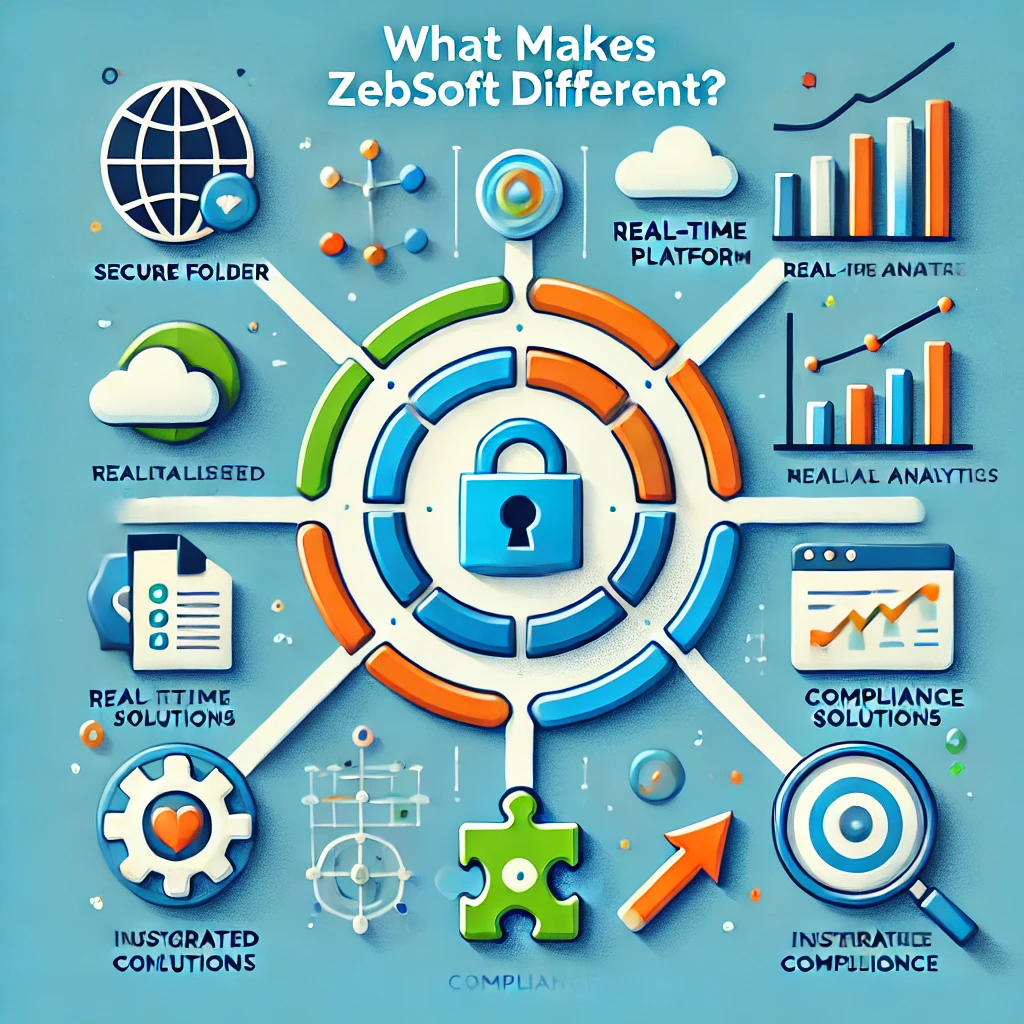
Reduce Risks. Enhance Confidence.
In today’s litigious regulatory landscape, managing risk effectively is critical to survival success.
In today’s litigious regulatory landscape, managing risk effectively is critical to survival success.
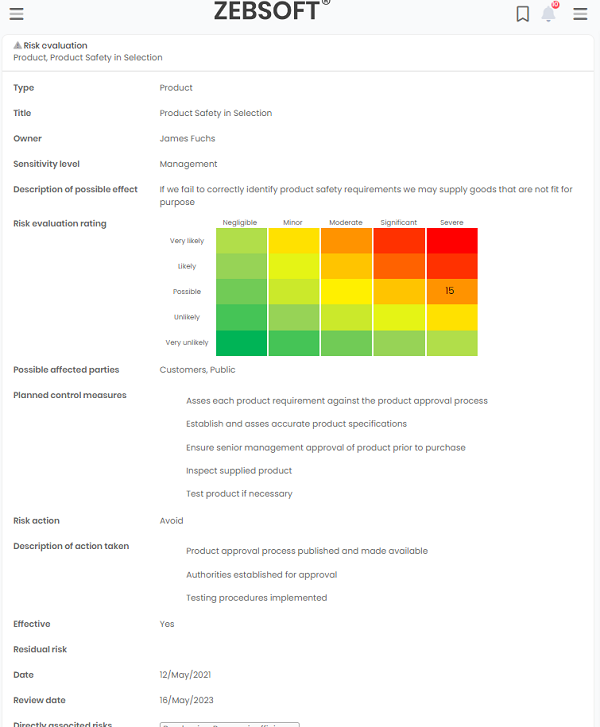
Proactive Risk Management with ZEBSOFT
ZEBSOFT empowers organizations to adopt a proactive approach to risk management, ensuring compliance and mitigating potential hazards across various domains.
Key Features for Proactive Risk Management
- Comprehensive Audit Coordination: Plan, perform, and respond effectively to audit programs, identifying and addressing risks systematically.
- Stakeholder Engagement: Maintain a detailed record of interested parties to ensure all risk-related communications and responsibilities are aligned.
- Regulatory Compliance Tracking: Keep an updated register of relevant legislation and standards to ensure ongoing regulatory compliance.
- Risk Identification and Monitoring: Highlight and track critical internal and external issues, providing early warnings of emerging risks.
- Environmental Risk Management: Address environmental risks, such as emissions and nuisances, with robust monitoring and mitigation strategies.
- COSHH Management: Maintain a detailed register of Control of Substances Hazardous to Health (COSHH) to ensure safe handling and compliance.
- Statements of Applicability: Create and maintain clear documentation of applicable controls and their relevance to organizational risk management.
- Scenario-Based Contingency Planning: Develop and implement contingency plans to address a wide range of risk scenarios, ensuring preparedness for unexpected events.
ZEBSOFT equips organizations with the tools to manage risks proactively, fostering resilience, compliance, and confidence in operational decision-making.
Legal & Regulatory Compliance Register with ZEBSOFT
ZEBSOFT simplifies the management of legal and regulatory obligations by providing a centralized platform to create and maintain a comprehensive compliance register.
Key Features of ZEBSOFT’s Compliance Register
- Comprehensive Legislation Tracking: Maintain a detailed register of applicable legislation and regulatory standards across domains like data protection, employment, and health & safety.
- Regulator Information: Include details of the relevant regulators to ensure compliance oversight is streamlined and accessible.
- Linked Resources: Provide direct links to authoritative websites and external resources for quick reference and verification.
- Document Integration: Reference controlled and external documents related to compliance, ensuring all necessary information is consolidated.
- Clear Summaries: Add concise summaries for each regulation, enabling easy understanding of obligations.
- Authorizations and Licenses: Track associated authorizations, licenses, consents, or records, ensuring proper documentation of regulatory requirements.
- Breach Impact Awareness: Highlight the consequences of non-compliance to reinforce the importance of adhering to regulations.
ZEBSOFT’s compliance register enables organizations to confidently manage their legal and regulatory requirements, reducing risk and ensuring adherence to critical standards.
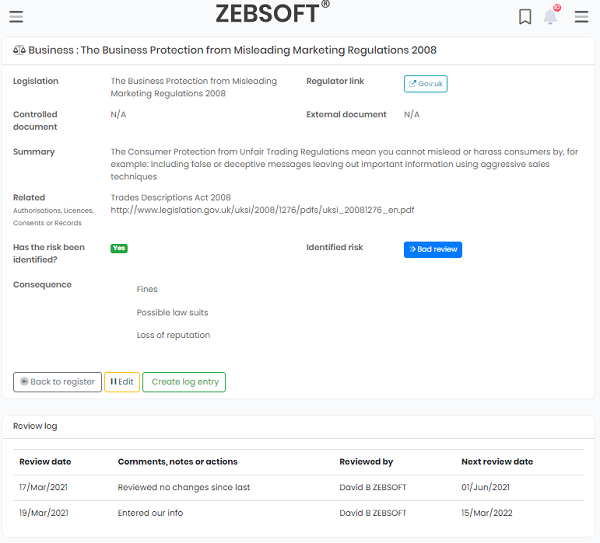
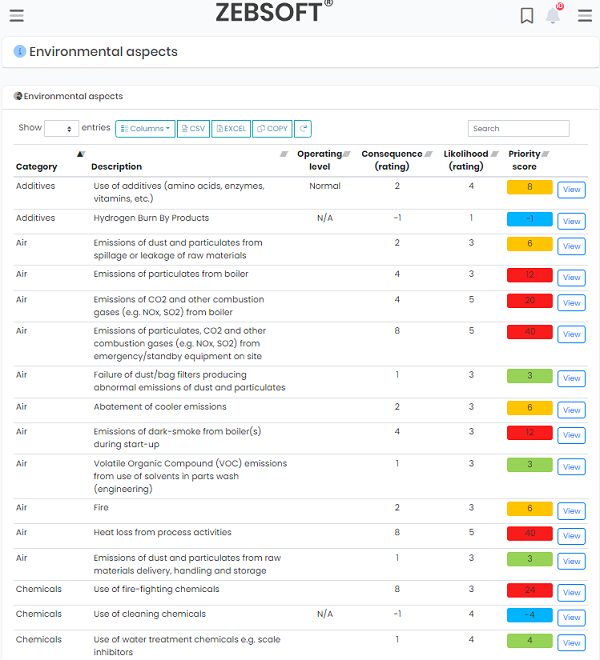
Simplified Environmental Aspects & Impacts Register with ZEBSOFT
ZEBSOFT makes it easy to manage environmental issues and risks with a detailed, organized register.
Key Features
- Categorized Issues: Organize issues like emissions, waste, and nuisances for clarity.
- Ownership: Assign responsibility for each issue to ensure action.
- Impact Descriptions: Document impacts for better understanding and planning.
- Legislation Links: Connect issues to relevant laws for compliance.
- Prioritization: Rate risks by likelihood and impact to focus on what matters most.
- Contingency Plans: Be prepared for normal and emergency scenarios.
- Site & Risk Association: Link issues to specific sites and risks for context.
- Action Tracking: Monitor progress with detailed risk actions.
- Review Scheduling: Keep records up-to-date with scheduled reviews.
ZEBSOFT simplifies environmental management, ensuring compliance, accountability, and sustainability.
Streamlined Reporting & Feedback Management with ZEBSOFT
ZEBSOFT empowers organizations to efficiently manage reporting and feedback processes, ensuring transparency and continuous improvement.
Key Features
- Incident Reporting: Easily log incidents and track resolution progress.
- Feedback Recording: Collect and manage feedback on health and safety, customers, employees, and incidents.
- Change Suggestions: Enable users to propose improvements or highlight risks.
- Automated Feedback Register: Centralize all submissions, including:
- Feedback title and submission date
- User details
- Feedback type (e.g., incident, health and safety, customer)
- Status (e.g., open, closed, new)
- Customizable Filtering: Sort feedback by type, status, or source for focused analysis.
- Export Options: Export registers as CSV or Excel files for further processing and reporting.
ZEBSOFT ensures seamless reporting and feedback management, promoting accountability, visibility, and actionable insights.
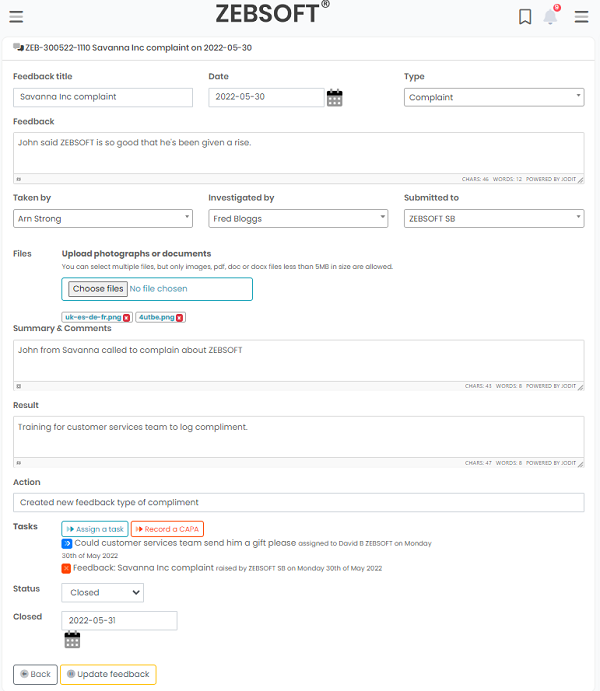
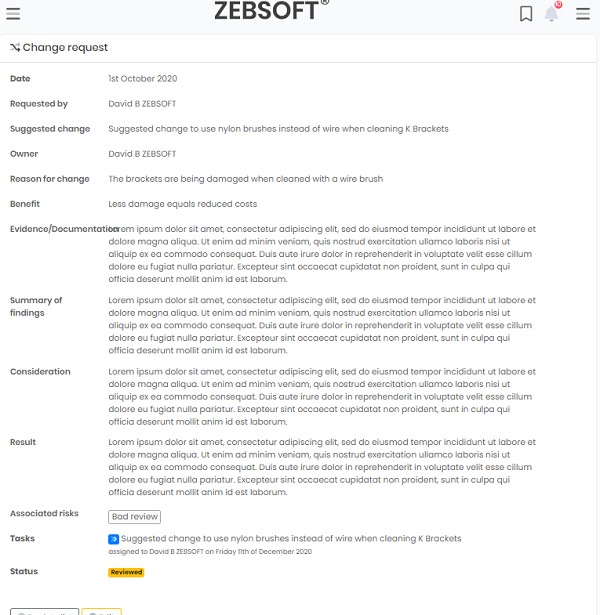
Managing Suggestions for Change with ZEBSOFT
ZEBSOFT simplifies the management of change suggestions, ensuring a transparent and actionable process for continuous improvement.
Key Features
- Change Suggestions: Users can propose changes, detailing the reason, benefit, and responsible owner.
- Centralized Register: All suggestions are automatically recorded, including:
- Submission date and description
- Requester and change owner
- Status (e.g., new, reviewed, adopted, not adopted)
- Customizable Sorting & Exporting: Sort suggestions by date, area, requester, change owner, or status, and export as CSV or Excel files for easy analysis.
- Detailed Updates: Enhance suggestions with:
- Additional evidence and documentation
- Findings and considerations
- Results and target dates
- Associated risks and tasks
- Risk Highlighting: Identify risks related to compliance, environmental, financial, health and safety, or information security.
ZEBSOFT provides an organized, efficient approach to managing change suggestions, driving accountability and measurable improvements.
User-Driven Risk Management with ZEBSOFT
ZEBSOFT empowers users to actively contribute to risk identification and management, fostering a proactive approach to organizational safety and compliance.
Key Features
-
Detailed Risk Reporting: Users can:
- Describe possible or observed risk effects.
- Suggest control measures.
- Identify affected parties.
-
Centralized Risk Register: Automatically compile risks into a searchable, sortable register, including:
- Risk type, title, and evaluation rating.
- Suggested actions and effective control status.
- Submission and review dates.
-
Risk Updates by Authorized Users: Refine risk details to include:
- Assigned risk owner and sensitivity level.
- Enhanced descriptions and risk actions (transfer, avoid, reduce, or ignore).
- Effectiveness of actions and associated risks or sites.
-
Risk Evaluation Tools: Use a colour-coded likelihood-severity grid to assess and prioritize risks effectively.
-
Automated Notifications: Ensure relevant stakeholders are promptly informed about new risks, updates, and actions via automated notifications.
ZEBSOFT enables a collaborative, transparent, and systematic approach to risk management, ensuring swift identification, evaluation, and mitigation.
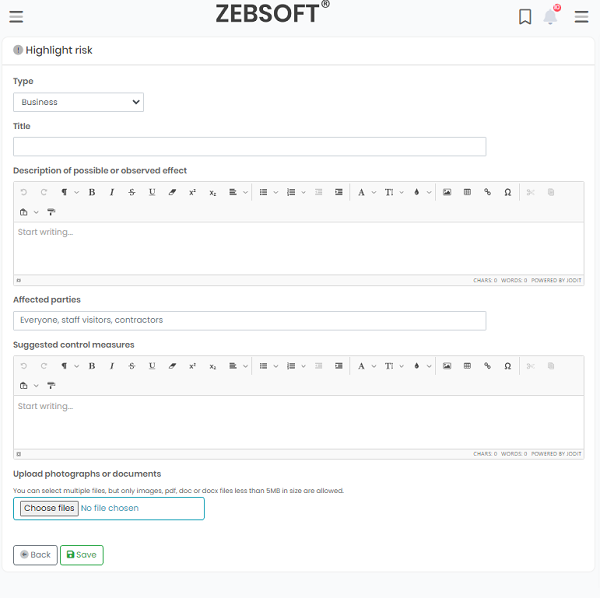
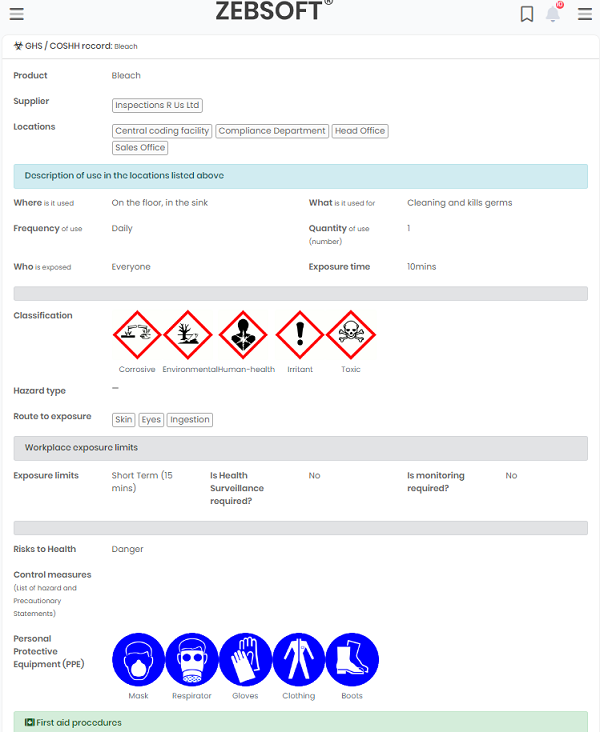
Control of Substances Hazardous to Health (COSHH) with ZEBSOFT
ZEBSOFT streamlines the tracking and management of hazardous substances, ensuring compliance with COSHH regulations and promoting workplace safety.
Key Features of COSHH Management
-
Comprehensive Substance Records: Maintain detailed entries for each hazardous substance, including:
- Supplier and location.
- Description of use and hazard classification.
- Exposure routes and limits.
-
Health and Safety Measures: Record essential safety details:
- Required PPE and control measures.
- First aid procedures and additional safety actions.
- Monitoring, ventilation, and surveillance needs.
-
Compliance Assurance: Link substances to applicable legislation and attach relevant documents for full regulatory alignment.
-
Assessor Oversight: Assign named assessors, include review dates, and ensure up-to-date compliance.
ZEBSOFT provides a structured, accessible platform to manage hazardous substances, safeguarding employees and ensuring robust COSHH compliance.
Why Risk Management is Key to Business Success
In today’s dynamic business world, effective risk management is essential for stability, growth, and resilience. Here’s why it matters:
Protects Finances: Identifying and addressing threats safeguards against unexpected financial losses, ensuring stability and a clear trajectory.
Improves Operations: Proactive risk management prevents disruptions, keeping operations efficient and cost-effective.
Informs Decisions: A clear understanding of risks allows businesses to make confident, well-informed choices.
Builds Trust: Demonstrating preparedness reassures stakeholders—employees, customers, and investors alike—that the business can handle challenges.
Ensures Compliance: Adhering to legal and regulatory standards avoids penalties and enhances corporate reputation.
Drives Competitive Edge: Businesses with strong risk strategies adapt faster, seize opportunities, and outpace competitors.
Saves Costs: Preventing losses, minimizing liabilities, and reducing insurance premiums lead directly to savings.
Supports Growth: Understanding risks enables expansion into new markets, launching products, or scaling operations with confidence.
Enhances Reputation: A reputation for sound risk management appeals to customers, investors, and partners.
Boosts Morale: Employees feel secure in a well-prepared company, fostering trust and a positive workplace culture.
Encourages Proactivity: A risk-aware culture inspires forward-thinking teams to innovate and spot opportunities early.
Risk management is more than avoiding pitfalls—it’s a strategic tool to protect assets, foster growth, and secure long-term success in an unpredictable world.
Zebra Software Limited
- Head office: Booths Hall, Booths Park, Knutsford, Cheshire, WA16 8GS.
- Registered office: Riverside, Mountbatten Way, Congleton CW12 1DY, United Kingdom
- Registered in England and Wales 11901161
- ICO number A8778081
Corporate
